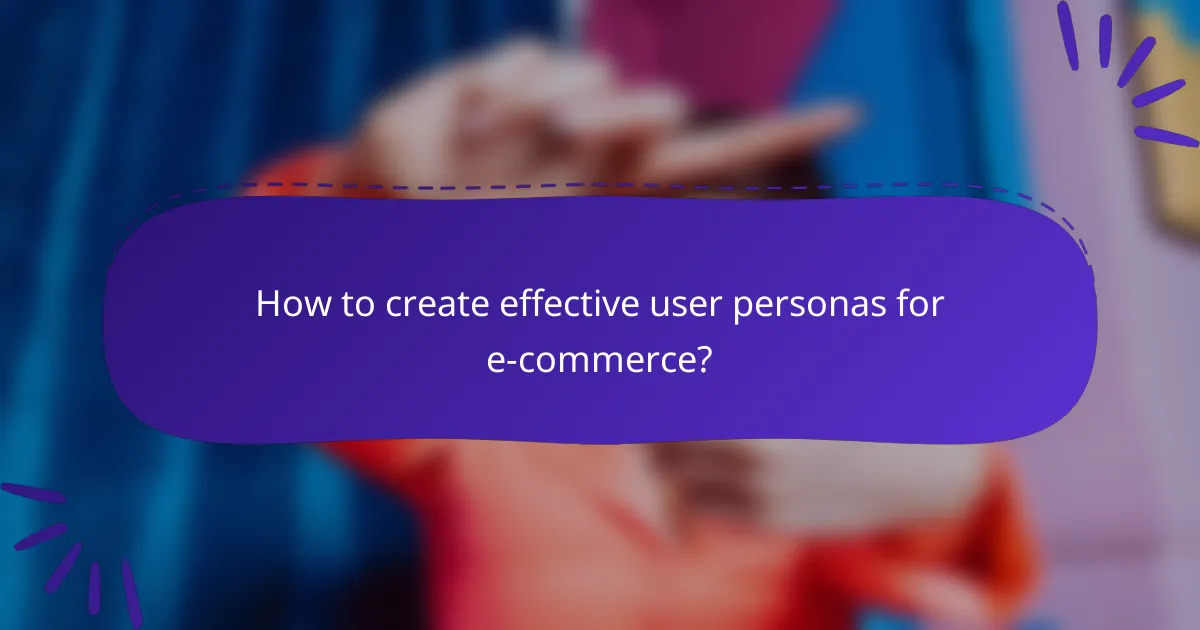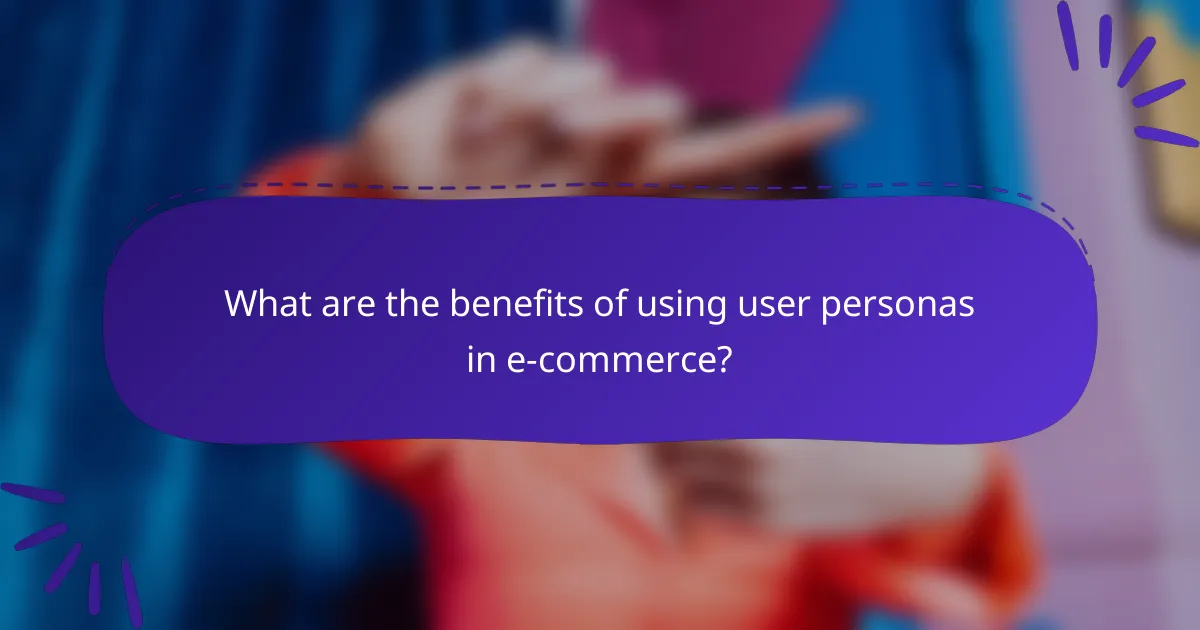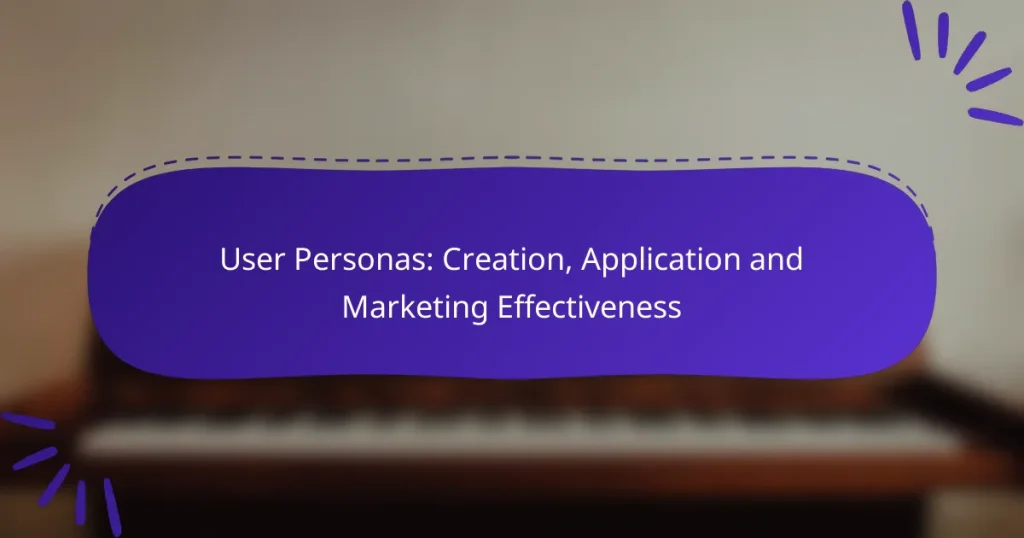User personas are essential tools in e-commerce, serving as semi-fictional representations of ideal customers based on data and insights. By understanding the characteristics, needs, and behaviors of these personas, businesses can tailor their marketing strategies to enhance engagement and drive sales effectively.

How to create effective user personas for e-commerce?
Creating effective user personas for e-commerce involves understanding your target audience’s characteristics, needs, and behaviors. This process helps tailor marketing strategies to resonate with specific customer segments, ultimately enhancing engagement and sales.
Identify target demographics
Start by defining the basic demographics of your potential customers, such as age, gender, income level, education, and geographic location. This foundational data helps in understanding who your customers are and what they might be looking for in your e-commerce offerings.
Utilize surveys and existing customer data to gather insights on these demographics. For instance, if your primary audience is young adults aged 18-24, consider how their preferences and shopping habits differ from older generations.
Conduct customer interviews
Customer interviews provide qualitative insights that quantitative data may miss. Engage with a diverse group of customers to discuss their shopping experiences, preferences, and pain points. This direct feedback can reveal motivations behind their purchasing decisions.
Prepare open-ended questions to encourage detailed responses. For example, ask about their favorite features of your website or what would improve their shopping experience. This information is invaluable for refining your user personas.
Analyze purchase behavior
Examine historical purchase data to identify trends and patterns in customer behavior. Look for factors such as average order value, frequency of purchases, and product preferences. This analysis helps in understanding what drives sales and customer loyalty.
Consider segmenting customers based on their buying habits. For example, frequent buyers may have different needs compared to occasional shoppers, allowing for more targeted marketing efforts.
Utilize analytics tools
Leverage analytics tools like Google Analytics, Shopify Analytics, or other e-commerce platforms to gather data on user behavior. These tools can provide insights into traffic sources, user engagement, and conversion rates, which are crucial for persona development.
Track metrics such as bounce rates and time spent on site to identify areas for improvement. This data can guide adjustments in your marketing strategies to better align with user expectations.
Segment by buyer journey stages
Segmenting customers by their stage in the buyer journey—awareness, consideration, and decision—allows for tailored messaging and offers. Each stage requires different marketing tactics to effectively guide customers toward a purchase.
For instance, customers in the awareness stage may respond well to educational content, while those in the decision stage might appreciate special discounts or testimonials. Understanding these nuances can significantly enhance your marketing effectiveness.

What are the key components of a user persona?
User personas are semi-fictional representations of your ideal customers, crafted from data and insights. They typically include demographic information, psychographic traits, shopping preferences, and challenges, providing a comprehensive view of the target audience.
Demographic information
Demographic information encompasses basic characteristics such as age, gender, income level, education, and location. This data helps in segmenting the audience and tailoring marketing strategies to specific groups. For instance, a brand targeting millennials may focus on social media platforms popular among that age group.
When creating user personas, gather demographic data through surveys, market research, or analytics tools. Aim for a diverse representation to ensure your marketing efforts resonate with various segments.
Psychographic traits
Psychographic traits delve into the attitudes, values, interests, and lifestyles of your target audience. Understanding these aspects allows marketers to connect on a deeper emotional level. For example, a persona that values sustainability may respond better to eco-friendly product messaging.
To identify psychographic traits, consider conducting interviews or focus groups. This qualitative data can reveal motivations and preferences that demographics alone cannot capture.
Shopping preferences
Shopping preferences refer to how consumers like to shop, including their preferred channels, payment methods, and influences on purchasing decisions. Knowing whether your audience prefers online shopping, in-store experiences, or a mix of both can shape your sales strategies.
Gather insights on shopping preferences through customer feedback and behavior analysis. For instance, if a significant portion of your audience prefers mobile shopping, optimizing your website for mobile devices becomes essential.
Challenges and pain points
Challenges and pain points are the obstacles or frustrations your target audience faces that your product or service can address. Identifying these issues is crucial for positioning your offerings as solutions. For example, a busy professional may struggle with time management, making a subscription service appealing.
To uncover these challenges, engage with your audience through surveys or social media interactions. Understanding their pain points allows you to tailor your messaging and product features effectively.

How to apply user personas in marketing strategies?
Applying user personas in marketing strategies involves tailoring your approach to meet the specific needs and preferences of different customer segments. By understanding these personas, businesses can create more effective marketing campaigns that resonate with their target audience.
Tailor content marketing efforts
To tailor content marketing efforts, start by creating content that speaks directly to the interests and pain points of each user persona. This can include blog posts, videos, and social media updates that reflect the language and values of your target audience.
For example, if one of your personas is a tech-savvy millennial, consider using modern slang and focusing on the latest technology trends in your content. Regularly review engagement metrics to refine your strategy and ensure your content remains relevant.
Optimize email marketing campaigns
Optimizing email marketing campaigns with user personas means segmenting your email list based on these personas. This allows you to send personalized messages that cater to the specific needs and behaviors of each group.
For instance, if you have a persona that prefers discounts, tailor your emails to highlight special offers. Use A/B testing to determine which subject lines and content types resonate best with each segment, improving open and click-through rates significantly.
Enhance product recommendations
Enhancing product recommendations involves using user personas to suggest products that align with their preferences and purchasing history. This can be achieved through personalized algorithms or curated lists that reflect each persona’s interests.
For example, if a persona frequently buys eco-friendly products, ensure that your recommendations prominently feature sustainable options. This targeted approach can increase conversion rates and customer satisfaction.
Improve customer service interactions
Improving customer service interactions with user personas means training your support team to recognize and respond to different personas effectively. Understanding each persona’s expectations can lead to more personalized and satisfactory service experiences.
For instance, a persona that values quick responses may appreciate a more streamlined communication approach, while another that prefers detailed explanations might benefit from thorough guidance. Regularly gather feedback to refine your service strategies based on persona insights.

What are the benefits of using user personas in e-commerce?
User personas in e-commerce provide a structured way to understand and target customers effectively. By creating detailed profiles based on demographics, behaviors, and preferences, businesses can tailor their marketing efforts to meet specific customer needs, leading to improved outcomes.
Increased customer engagement
User personas help businesses create more relevant content and product offerings, which significantly boosts customer engagement. When marketing messages resonate with the target audience, customers are more likely to interact with the brand through comments, shares, and purchases.
For instance, an e-commerce site selling outdoor gear can use personas to craft campaigns that appeal to adventure seekers, highlighting products that match their interests. This targeted approach fosters a deeper connection with customers, encouraging them to explore more of what the brand offers.
Higher conversion rates
Utilizing user personas can lead to higher conversion rates by ensuring that marketing strategies align with customer expectations. When customers see products and promotions that reflect their preferences, they are more likely to complete a purchase.
For example, a fashion retailer can segment its audience into personas based on style preferences, allowing for personalized recommendations that cater to each group. This tailored experience can increase sales by making customers feel understood and valued.
Better alignment of marketing strategies
User personas provide clarity on who the target audience is, enabling businesses to align their marketing strategies effectively. By understanding the motivations and pain points of different personas, companies can create campaigns that address specific needs.
For instance, a tech company may develop separate marketing strategies for tech-savvy millennials and older, less tech-oriented customers. This focused approach ensures that messaging is relevant and impactful, maximizing the effectiveness of marketing efforts.
Enhanced customer loyalty
When e-commerce businesses use user personas to tailor experiences, they can foster stronger customer loyalty. Personalized interactions and targeted offers make customers feel appreciated, encouraging repeat purchases and brand advocacy.
For example, a subscription box service can use personas to send curated products that match individual preferences, enhancing the overall customer experience. Satisfied customers are more likely to remain loyal and recommend the brand to others, driving long-term growth.

How to validate user personas for accuracy?
Validating user personas for accuracy involves testing assumptions against real user behavior and feedback. This process ensures that the personas reflect the actual needs and preferences of your target audience, leading to more effective marketing strategies.
Conduct A/B testing
A/B testing is a practical method for validating user personas by comparing two versions of a marketing asset to see which performs better. For instance, you can test different messaging or visuals tailored to specific personas to determine which resonates more with your audience.
When conducting A/B tests, ensure you have a clear hypothesis and measurable goals, such as click-through rates or conversion rates. Aim for a sample size that provides statistically significant results, typically in the hundreds or thousands, depending on your overall audience size.
Gather feedback from sales teams
Sales teams interact directly with customers and can provide valuable insights into user personas. Regularly solicit their feedback on customer interactions, common objections, and questions that arise during the sales process.
Consider setting up structured feedback sessions or surveys to capture this information. This input can help refine your personas by highlighting gaps in understanding or confirming existing assumptions, ultimately enhancing your marketing effectiveness.

